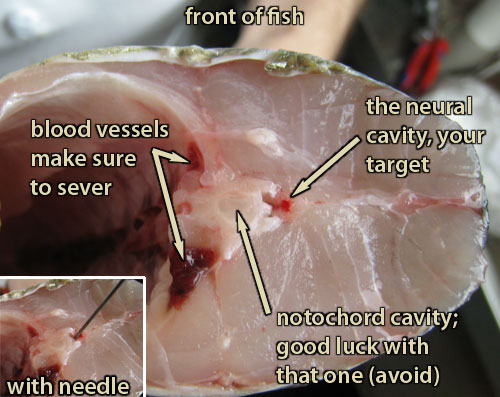posted by Dave Arnold
Ok. I know the blog has gotten a bit gruesome with all the fish killing. This will be the last Ike Jime post for a little while; but before we move on I wanted to post some pointers for those wishing to try the technique.
Ike Jime, for those who don’t know, is a Japanese fish killing technique involving bleeding and spinal cord destruction. You can read about it here, here, and here.
Here is the basic technique taken from one of our earlier posts:

Some notes on the initial cuts:

When you put the knife under the gill flap, try not to aim too far forward on the fish. If you aim forward you will be cutting into the base of the skull, which is easy on small fish but not on big fish. Next, I think it’s a good idea to make a cut into the brain to destroy it (not pictured). It makes the process more humane, but it is tough - it’s easy for a beginner to miss the brain. When you cut through the tail, don’t cut all the way through. You’ll use the tail as a handle.

Notes on the needle (how to do spinal cord destruction):
Any stiff, thin wire will do. Bigger fish can take bigger wires. Make sure the wire is long enough to run the entire length of the fish. We sharpen the business end of the wires on a sharpening stone. It is extremely easy to get confused with this procedure because it isn’t readily apparent where you should put the needle. Here are some pictures to erase all doubt:


You know that you’ve hit the right spot when the needle goes in easily and the fish’s muscles contract as the needle destroys the spinal cord. Don’t leave the needle in –it will send more false signals to the muscles. The whole point of  this procedure is to prevent errant muscle contraction. I suspect it’s best to use as big a needle as will easily fit, because it will better destroy the spinal cord and avoid slipping past it. Note:  you want to do this procedure rapidly. The faster you destroy the spinal cord, the better. We think that the reason spinal cord destruction fish tasted better to us than ones that had been killed and immediately filleted is because it took longer to fillet than to destroy the spinal cord.
Notes on bleeding the fish:
After spinal cord destruction, you should place the fish in ice water to bleed out. It is important to make sure the cut blood vessels are open and not covered over (by the tail flapping back into position, for example). This is the part of the process on which we have done the least work. Our future areas of investigation:Â bleeding in slightly warmer water, bleeding in salt water, etc, etc.
Hope this helps any would-be Ike Jime masters. If you want to see a live demonstration, come to our Star Chefs demo next Tuesday, or click here to see it on video.

Can we get some pictures from the Tuna cutting today?
Please. Forgot to say please.
Unfortunately, I didn’t have my camera. There was a video taken, maybe I can get stills from it. It was a beautiful fish. Delicious too. Chef Suzuki is the man. Did you see that two foot tuna knife from Korin?
Scientists at Dartmouth put a dead salmon in a functional MRI machine, showed it pictures of humans, and monitored its brain activity as it responded to the pictures. According to the scan, the fish was still thinking hard.
http://www.wired.com/wiredscience/2009/09/fmrisalmon/
Maybe you need a kitchen fMRI to test levels of neural activity in fish; and even track whether particular thoughts or emotions affect their flavor.
Spearfishers typically “brain” a fish vertically through the top of the skull or cut the gills to bleed it out if sharks are not a problem.
Cool. The trick (and I don’t know how it works with swordfish) is to knock out the spine and the brain.